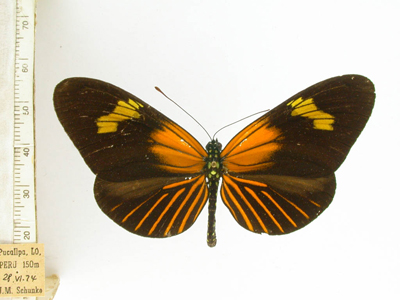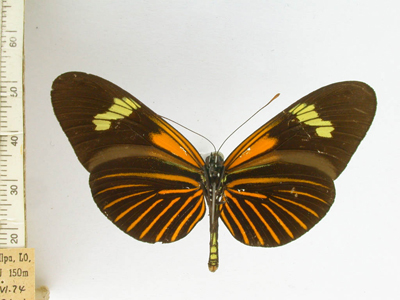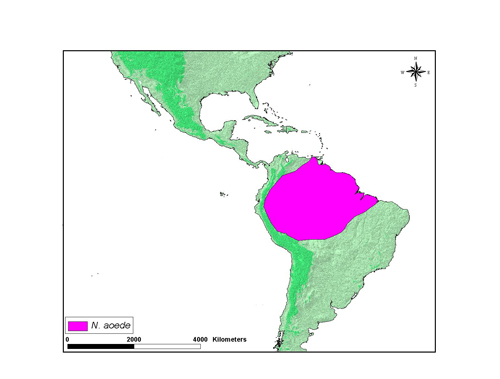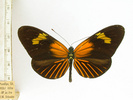Neruda aoede described in Nerëis Hübner, [1806]
Margarita Beltrán and Andrew V. Z. BrowerIntroduction
Neruda aoede may be distinguished from its many Müllerian mimics by the parallel rows of yellow spots on the sides of the abdomen. Adult males exhibit the characteristic expansion of the costal part of the hindwing, coated with androconial scales on the dorsal surface.Characteristics
Early stages: Eggs are white and approximately 0.9 x 0.7 mm (h x w). Females usually place 10 to 200 eggs on growing shoots of the host plant. Mature larvae have a maroon body with white bands, with white scoli and black head. Caterpillars are gregarious (Brown, 1981).
Geographical Distribution
Neruda aoede is distributed in the Amazon Basin. The map below shows an approximate representation of the geographic distribution of this species. The original data used to draw these maps are derived from Brown (1979) which is available at Keith S. Brown Jr. (1979). Ecological Geography and Evolution in Neotropical Forests.
Geographical races/subspecies
Neruda aoede aoede (Hübner, [1813]) (described in Nerëis) widespread in AmazoniaNeruda aoede aliciae Neukirchen, 2000 eastern Ecuador
Neruda aoede astydamia (Erichson, [1849]) (described in Heliconia) Guyana
Neruda aoede auca Neukirchen, 1997 eastern Ecuador
Neruda aoede ayacuchensis (Neukirchen, 1992) (described in Heliconius) Venezuela
Neruda aoede bartletti (H. Druce, 1876) (described in Heliconius) eastern Peru
= eliconius vedius Staudinger, 885
= Heliconius aoede f. metella Neustetter, 1932
Neruda aoede centurius (Neukirchen, 1994) (described in Heliconius) Fench Guiana
Neruda aoede cupidineus (Stichel, 1906) (described in Heliconius) eastern Peru
= Heliconia bartletti var. reducta Oberthür, 1920
Neruda aoede ammelina (Oberthür, 1920) (described in Heliconia) Guyana
Neruda aoede eurycleia (K/ S/ Brown, 1973) (described in Heliconius) Brazil, Matto Grosso
Neruda aoede faleria (Fruhstorfer, 1910) (described in Heliconius) Brazil, Matto Grosso
Neruda aoede lucretius (Weymer, 1891) (described in Heliconius) Brazil, Amazonas
= Heliconius aoede aoede f. postalbimaculata Bryk, 1953 (unavailable infrasubspecific name)
Neruda aoede manu (Lamas, 1976) (described in Heliconius) southeastern Peru
Neruda aoede philipi (K. S. Brown, 1976) (described in Heliconius) eastern Bolivia
(new ssp.) K. S. Brown, ms., Brazil
Habits
N. aoede occurs from sea level to 1,300 m in deep forests. Usually individuals fly slowly and in the middlestory. Adults roost in small groups at night at 2-10 m above ground (Brown, 1981).
Hostplant: N. aoede larvae feed primarily on plants from the genera Dilkea and Mitostemma (Brown, 1981).
References
Brown K. S. 1981 The Biology of Heliconius and Related Genera. Annual Review of Entomology 26, 427-456.
Hübner J. 1813. Sammlung europäischer [sic] Schmetterlinge. Augsburg, Author. Plate 142.
Lamas, G. (Ed.) 2004. Atlas of Neotropical Lepidoptera. Checklist: Part 4A Hesperioidea - Papiionoidea. Scientific Publishers/Association of Tropical Lepidoptera, Gainesville.
Title Illustrations

| Scientific Name | Neruda aoede cupidineus |
|---|---|
| Specimen Condition | Dead Specimen |
| Sex | Male |
| View | dorsal |
| Collection | Gerardo Lamas |
| Image Use |
 This media file is licensed under the Creative Commons Attribution-NonCommercial-ShareAlike License - Version 3.0. This media file is licensed under the Creative Commons Attribution-NonCommercial-ShareAlike License - Version 3.0.
|
| Copyright |
©

|
| Scientific Name | Neruda aoede cupidineus |
|---|---|
| Specimen Condition | Dead Specimen |
| Sex | Male |
| View | ventral |
| Collection | Gerardo Lamas |
| Image Use |
 This media file is licensed under the Creative Commons Attribution-NonCommercial-ShareAlike License - Version 3.0. This media file is licensed under the Creative Commons Attribution-NonCommercial-ShareAlike License - Version 3.0.
|
| Copyright |
©

|
About This Page

University of Cambridge, Cambridge, UK

Middle Tennessee State University, Murfreesboro, Tennessee, USA
Correspondence regarding this page should be directed to Margarita Beltrán at and Andrew V. Z. Brower at
Page copyright © 2011 and
 Page: Tree of Life
Neruda aoede described in Nerëis Hübner, [1806].
Authored by
Margarita Beltrán and Andrew V. Z. Brower.
The TEXT of this page is licensed under the
Creative Commons Attribution-NonCommercial-ShareAlike License - Version 3.0. Note that images and other media
featured on this page are each governed by their own license, and they may or may not be available
for reuse. Click on an image or a media link to access the media data window, which provides the
relevant licensing information. For the general terms and conditions of ToL material reuse and
redistribution, please see the Tree of Life Copyright
Policies.
Page: Tree of Life
Neruda aoede described in Nerëis Hübner, [1806].
Authored by
Margarita Beltrán and Andrew V. Z. Brower.
The TEXT of this page is licensed under the
Creative Commons Attribution-NonCommercial-ShareAlike License - Version 3.0. Note that images and other media
featured on this page are each governed by their own license, and they may or may not be available
for reuse. Click on an image or a media link to access the media data window, which provides the
relevant licensing information. For the general terms and conditions of ToL material reuse and
redistribution, please see the Tree of Life Copyright
Policies.
- First online 22 February 2007
- Content changed 09 December 2011
Citing this page:
Beltrán, Margarita and Andrew V. Z. Brower. 2011. Neruda aoede described in Nerëis Hübner, [1806]. Version 09 December 2011 (under construction). http://tolweb.org/Neruda_aoede/72877/2011.12.09 in The Tree of Life Web Project, http://tolweb.org/











 Go to quick links
Go to quick search
Go to navigation for this section of the ToL site
Go to detailed links for the ToL site
Go to quick links
Go to quick search
Go to navigation for this section of the ToL site
Go to detailed links for the ToL site